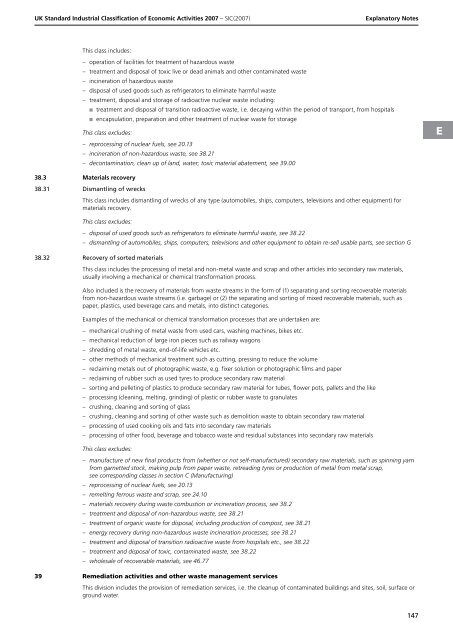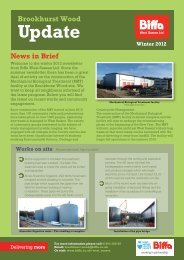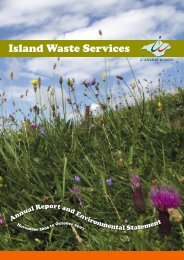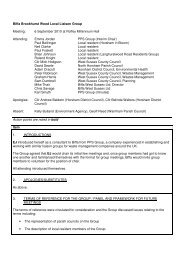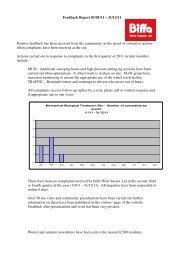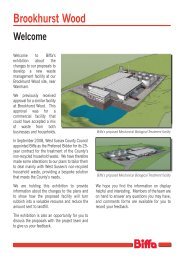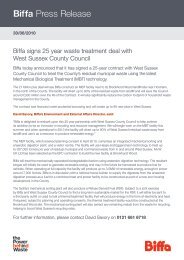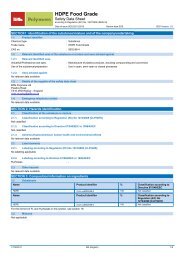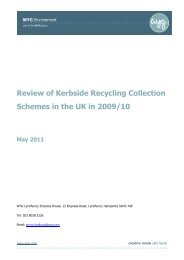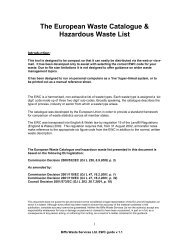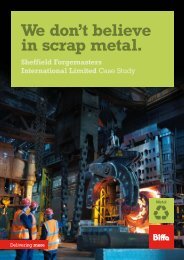detailed explanation for each SIC code - Biffa
detailed explanation for each SIC code - Biffa
detailed explanation for each SIC code - Biffa
Create successful ePaper yourself
Turn your PDF publications into a flip-book with our unique Google optimized e-Paper software.
UK Standard Industrial Classification of Economic Activities 2007 – <strong>SIC</strong>(2007)<br />
Explanatory Notes<br />
This class includes:<br />
– operation of facilities <strong>for</strong> treatment of hazardous waste<br />
– treatment and disposal of toxic live or dead animals and other contaminated waste<br />
– incineration of hazardous waste<br />
– disposal of used goods such as refrigerators to eliminate harmful waste<br />
– treatment, disposal and storage of radioactive nuclear waste including:<br />
■ treatment and disposal of transition radioactive waste, i.e. decaying within the period of transport, from hospitals<br />
■ encapsulation, preparation and other treatment of nuclear waste <strong>for</strong> storage<br />
This class excludes:<br />
– reprocessing of nuclear fuels, see 20.13<br />
– incineration of non-hazardous waste, see 38.21<br />
– decontamination, clean up of land, water; toxic material abatement, see 39.00<br />
E<br />
38.3 Materials recovery<br />
38.31 Dismantling of wrecks<br />
This class includes dismantling of wrecks of any type (automobiles, ships, computers, televisions and other equipment) <strong>for</strong><br />
materials recovery.<br />
This class excludes:<br />
–<br />
–<br />
disposal of used goods such as refrigerators to eliminate harmful waste, see 38.22<br />
dismantling of automobiles, ships, computers, televisions and other equipment to obtain re-sell usable parts, see section G<br />
38.32 Recovery of sorted materials<br />
This class includes the processing of metal and non-metal waste and scrap and other articles into secondary raw materials,<br />
usually involving a mechanical or chemical trans<strong>for</strong>mation process.<br />
Also included is the recovery of materials from waste streams in the <strong>for</strong>m of (1) separating and sorting recoverable materials<br />
from non-hazardous waste streams (i.e. garbage) or (2) the separating and sorting of mixed recoverable materials, such as<br />
paper, plastics, used beverage cans and metals, into distinct categories.<br />
Examples of the mechanical or chemical trans<strong>for</strong>mation processes that are undertaken are:<br />
–<br />
–<br />
–<br />
–<br />
–<br />
–<br />
–<br />
–<br />
–<br />
–<br />
–<br />
–<br />
mechanical crushing of metal waste from used cars, washing machines, bikes etc.<br />
mechanical reduction of large iron pieces such as railway wagons<br />
shredding of metal waste, end-of-life vehicles etc.<br />
other methods of mechanical treatment such as cutting, pressing to reduce the volume<br />
reclaiming metals out of photographic waste, e.g. fixer solution or photographic films and paper<br />
reclaiming of rubber such as used tyres to produce secondary raw material<br />
sorting and pelleting of plastics to produce secondary raw material <strong>for</strong> tubes, flower pots, pallets and the like<br />
processing (cleaning, melting, grinding) of plastic or rubber waste to granulates<br />
crushing, cleaning and sorting of glass<br />
crushing, cleaning and sorting of other waste such as demolition waste to obtain secondary raw material<br />
processing of used cooking oils and fats into secondary raw materials<br />
processing of other food, beverage and tobacco waste and residual substances into secondary raw materials<br />
This class excludes:<br />
– manufacture of new final products from (whether or not self-manufactured) secondary raw materials, such as spinning yarn<br />
from garnetted stock, making pulp from paper waste, retreading tyres or production of metal from metal scrap,<br />
see corresponding classes in section C (Manufacturing)<br />
–<br />
–<br />
–<br />
–<br />
reprocessing of nuclear fuels, see 20.13<br />
remelting ferrous waste and scrap, see 24.10<br />
materials recovery during waste combustion or incineration process, see 38.2<br />
treatment and disposal of non-hazardous waste, see 38.21<br />
– treatment of organic waste <strong>for</strong> disposal, including production of compost, see 38.21<br />
–<br />
–<br />
–<br />
–<br />
energy recovery during non-hazardous waste incineration processes, see 38.21<br />
treatment and disposal of transition radioactive waste from hospitals etc., see 38.22<br />
treatment and disposal of toxic, contaminated waste, see 38.22<br />
wholesale of recoverable materials, see 46.77<br />
39 Remediation activities and other waste management services<br />
This division includes the provision of remediation services, i.e. the cleanup of contaminated buildings and sites, soil, surface or<br />
ground water.<br />
147


